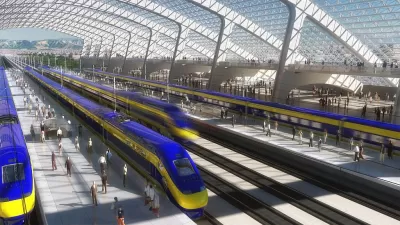With costs rising from $40 billion to $105 billion, the California High-Speed Rail project is still moving slowly along, though with a heftier price tag.

The California High-Speed Rail Authority (CHSRA) recently released the draft 2022 business plan for the California High-Speed Rail project. The draft business plan adds another $5 billion in cost to the already delayed and increasingly expensive project.
An article published by Roads & Bridges shares news of the new business plan, aggregating original coverage by Kathleen Ronayne for the Associated Press.
As noted by both articles, the estimated cost of the project was $40 billion when voters approved bond funding for the project in 2008. The project estimate now totals $105 billion.
Both articles provide coverage of the current funding opportunities in the mix for the project. California Governor Gavin Newsom's draft budget for the year, for example, proposes billions of dollars for rail and transportation projects, which could contribute funding if approved by the State Legislature. Meanwhile, Democrats in the California State Legislature closed out the 2021 legislative session by trying to revoke funding from the 2008 bond.
Then there is the federal government's see-sawing support for the project:
"Back in May 2019, the Federal Railroad Administration announced it was officially terminating its agreement with the CHSRA for the high-speed rail project, canceling nearly $1 billion in funding," according to Roads and Bridges. The Biden administration has since returned the funding, according to the article.
Governor Newsom has also wavered in support of the project in the past: In February 2019, Newsom announced plans to scale back the high-speed rail project.
FULL STORY: CALIFORNIA HIGH-SPEED RAIL AUTHORITY RELEASES DRAFT 2022 BUSINESS PLAN

Alabama: Trump Terminates Settlements for Black Communities Harmed By Raw Sewage
Trump deemed the landmark civil rights agreement “illegal DEI and environmental justice policy.”

Planetizen Federal Action Tracker
A weekly monitor of how Trump’s orders and actions are impacting planners and planning in America.

The 120 Year Old Tiny Home Villages That Sheltered San Francisco’s Earthquake Refugees
More than a century ago, San Francisco mobilized to house thousands of residents displaced by the 1906 earthquake. Could their strategy offer a model for the present?

In Both Crashes and Crime, Public Transportation is Far Safer than Driving
Contrary to popular assumptions, public transportation has far lower crash and crime rates than automobile travel. For safer communities, improve and encourage transit travel.

Report: Zoning Reforms Should Complement Nashville’s Ambitious Transit Plan
Without reform, restrictive zoning codes will limit the impact of the city’s planned transit expansion and could exclude some of the residents who depend on transit the most.

Judge Orders Release of Frozen IRA, IIJA Funding
The decision is a victory for environmental groups who charged that freezing funds for critical infrastructure and disaster response programs caused “real and irreparable harm” to communities.
Urban Design for Planners 1: Software Tools
This six-course series explores essential urban design concepts using open source software and equips planners with the tools they need to participate fully in the urban design process.
Planning for Universal Design
Learn the tools for implementing Universal Design in planning regulations.
Jessamine County Fiscal Court
Caltrans
Institute for Housing and Urban Development Studies (IHS)
City of Grandview
Harvard GSD Executive Education
Toledo-Lucas County Plan Commissions
Salt Lake City
NYU Wagner Graduate School of Public Service





























